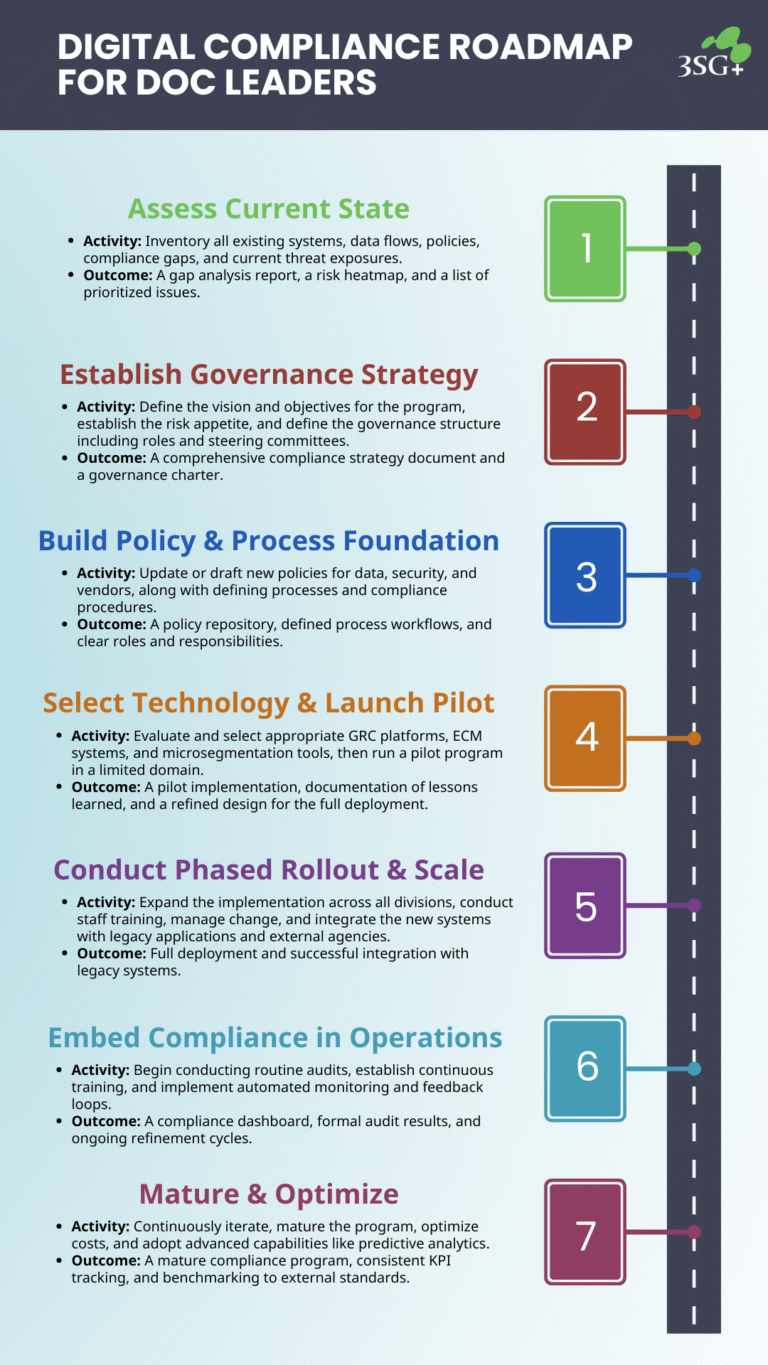
Departments of Corrections (DOCs) face a uniquely complex challenge when managing operations, security, and information technology. They stand at the intersection of public service and security, constantly balancing the need to ensure the safety of staff, inmates, and the public with the demands of public oversight and constrained budgets.
Compounding this difficulty are expanding regulatory expectations and the persistent threat of cybersecurity attacks. DOCs must manage highly sensitive data—including behavioral information, offender medical records, and security logs—all while ensuring continuity of operations within secure environments and supporting necessary digital transformation initiatives.
The systems and functions within correctional facilities—such as managing medical care, behavioral health, integrating with courts and parole systems, and handling staff HR—generate massive volumes of records. This content includes legal, psychological, health data (subject to HIPAA), grievance reports, staff human resources files, vendor contracts, and facility maintenance records. When these vital systems are fragmented, overly reliant on paper, or lack proper auditability, the institution faces significant risks. These risks include the unauthorized access to or loss of sensitive records, the inability to generate timely audit reports for oversight reviews, exposure to noncompliance vulnerabilities under rules like CJIS and HIPAA, and potential legal exposure, fines, and reputational damage.
Building a cohesive digital compliance program is a necessity for DOC leaders to develop a strategy that combines policy, process, and technology to not only mitigate these risks but also to elevate the institution’s overall security posture and streamline daily operations. This modernization requires more than simple technology upgrades; by following a defined roadmap, leaders can successfully embed compliance into daily practices, strengthen digital trust, and position their staff and institutions for long-term success.
Core Principles of Digital Compliance in Corrections
A modern digital compliance approach for corrections is built on five core, interlinked principles. These principles guide the development of a sustainable and effective compliance program:
1. Governance, Risk, and Compliance (GRC) as a Living Framework
A compliance program cannot be a one-time initiative; it must constantly evolve to adapt to changes in technology, threats, and regulations. Governance establishes accountability, decision rights, and roles. Risk management involves identifying, evaluating, and mitigating potential exposures. Compliance ensures that all legal and regulatory obligations are consistently met. By integrating established GRC protocols with technical enforcement, DOCs ensure these governance frameworks are enforceable through real-time controls and architecture, preventing them from being merely theoretical.
Key GRC activities include evaluating existing processes and systems to uncover vulnerabilities (Risk Identification and Assessment), creating and operationalizing governance frameworks aligned with regulatory standards (Policy Development), and assessing risks in the entire supplier and contractor ecosystem (Vendor/Third-Party Risk Management). Furthermore, GRC ensures the department can prepare structured documentation for audits (Audit Readiness and Reporting) and shift from point-in-time assessments to ongoing oversight (Continuous Compliance Monitoring).
2. Security Architecture and Enforcement
Policies, while necessary, require technical controls for proper enforcement. Modern security architectures, such as Zero Trust principles, are essential, but technical complements like microsegmentation are key for corrections environments. Microsegmentation partitions the network into isolated zones, which limits the lateral spread of any threat and helps to isolate critical assets, such as inmate health systems, justice systems, or inmate records. This technical enforcement ensures that even if one part of the network is compromised, the most sensitive data remains secure.
3. Information Management (ECM and Audit Trails)
Central to compliance is the proper management of records: documents must be securely stored, versioned, retained according to policy, auditable, and accessible only to authorized parties. An enterprise content management (ECM) system is essential, particularly in a corrections setting, because it supports crucial functions like secure access, detailed audit trails, retention policies, metadata tagging, and automated workflows.
This is foundational because DOCs manage vast volumes of documentation, from intake and release documents to incident reports, medical history, grievances, and facility orders. ECM eliminates information silos, ensuring data integrity, providing enhanced compliance via secure access rules and versioning, and enabling better reporting with real-time insights.
4. Integration, Interoperability, and Automation
The compliance and security stack must seamlessly integrate with various operational systems, including offender management systems, HR systems, health systems, and court systems. Automation is critical here, as it reduces human error, increases the speed of operations, and streamlines tasks during audits or in the event of an incident response. By automating key processes, compliance is supported through the enforcement of standardized workflows.
5. Monitoring, Measurement, and Continuous Improvement
Compliance must be reportable, measurable, and actionable. DOCs must continuously assess their compliance posture, discover gaps, and refine controls using dashboards, audit logs, alerts, and key metrics. This commitment to continuous improvement transitions compliance from a reactive checkbox mentality to a proactive, optimized approach.
The 7-Phase Digital Compliance Roadmap
A modern digital compliance approach for corrections is built on five core, interlinked principles. These principles guide the development of a sustainable and effective compliance program.

Measuring Success and Maturity
A compliance roadmap’s value is realized through measurable progress. Corrections leaders must translate abstract ideas like “compliance posture” into tangible indicators of audit readiness, risk reduction, and operational performance. Tracking these metrics allows DOCs to justify ongoing investment, demonstrate improvements, and benchmark their progress.
Key metrics for measuring success and maturity include:
Audit Findings
Measure the number and severity of compliance exceptions or audit findings year over year. A consistent downward trend validates improved governance and adherence to regulatory requirements like CJIS and HIPAA.
Audit Readiness Time
Measure the average time required to gather and present documentation for an audit. Agencies that can produce records in hours instead of days demonstrate higher maturity and stronger ECM practices.
Workflow Automation Rate
Measure the percentage of critical processes, such as HR requests, incident reporting, or inmate grievances, that have been digitized and automated. Higher rates reduce human error, speed up operations, and guarantee standardized processes.
Vendor Compliance Coverage
Measure the percentage of third-party vendors or contractors that undergo formal annual risk and compliance reviews. Unassessed vendors are a significant source of exposure, especially since correctional facilities rely heavily on contracted services.
Incident Detection and Response Time
Measure the mean time needed to detect and respond to security or compliance incidents. Shorter response times are a clear indicator of a mature security posture and the ability to mitigate potential damage quickly.
System Adoption and Utilization
Measure the percentage of staff actively using the compliance tools or ECM platform as designed. The best technology is useless without adoption, and tracking usage confirms that compliance is truly embedded into daily operations.
Download the Full Whitepaper
To explore a detailed breakdown of the GRC protocols, technical components, and the step-by-step implementation guide, download the full whitepaper: Building Digital Compliance: A Roadmap for DOC Leaders.
Conclusion and Next Steps
Building digital compliance is fundamentally about more than simply meeting regulations; it’s about safeguarding highly sensitive information, streamlining critical operations, and building essential trust with oversight bodies and the public. For correctional leaders, the initial steps should be strategic and focused to quickly demonstrate value and build a sustainable foundation.
The journey begins with a Current State Assessment to establish a baseline of security gaps and content management practices. It requires you to Engage Stakeholders Early—compliance needs buy-in from all parties, including operations, IT, executive leadership, health services, and security, often formalized through a cross-functional steering group. Next, leaders should Pilot a High-Impact Use Case, such as automating inmate grievance workflows or centralizing medical record access, to produce visible, early results. Finally, this must be followed by the development of a multi-year strategy.
A comprehensive roadmap—integrating GRC, ECM, and technical enforcement like microsegmentation—is a definitive strategy for DOC leaders to achieve modern operational efficiency, reduce catastrophic risk, and enhance institutional accountability.
Ready to Begin Your Digital Compliance Journey?
3SG Plus is an authorized OnBase reseller, integrator, and professional services provider, specializing in digital transformation for the public sector. With two decades of experience, we provide customized GRC services, ECM deployments, advanced Security Services like microsegmentation, and platform integrations designed to boost transparency and operational efficiency for Departments of Corrections. We provide comprehensive support, from onboarding assistance to post-implementation support, helping you maximize the value and impact of your software solutions.
